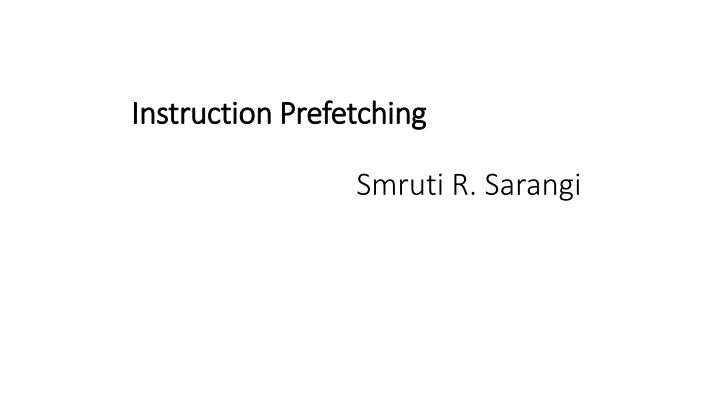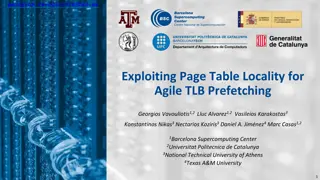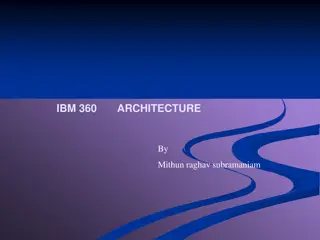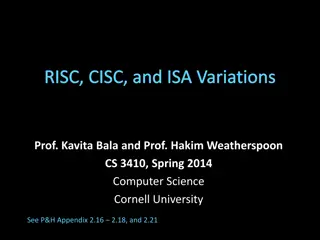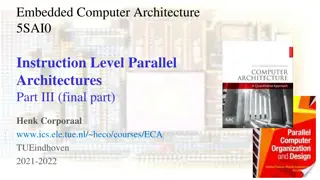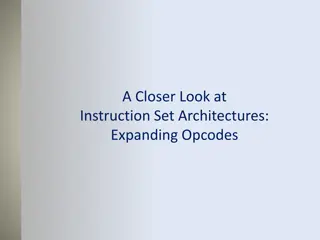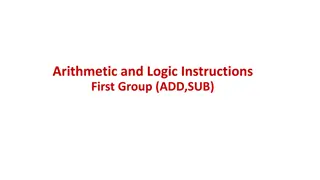Optimizing Instruction Prefetching for Improved Performance
Instruction prefetching is essential for reducing performance penalties caused by cache misses in processors. By predicting and fetching memory addresses ahead of time, prefetching can mitigate stalls in the instruction pipeline and enhance overall system efficiency. This article delves into the motivations, strategies, and patterns involved in instruction prefetching, offering insights on how to optimize this process for better performance in modern computing systems.
Download Presentation

Please find below an Image/Link to download the presentation.
The content on the website is provided AS IS for your information and personal use only. It may not be sold, licensed, or shared on other websites without obtaining consent from the author.If you encounter any issues during the download, it is possible that the publisher has removed the file from their server.
You are allowed to download the files provided on this website for personal or commercial use, subject to the condition that they are used lawfully. All files are the property of their respective owners.
The content on the website is provided AS IS for your information and personal use only. It may not be sold, licensed, or shared on other websites without obtaining consent from the author.
E N D
Presentation Transcript
Instruction Prefetching Instruction Prefetching Smruti R. Sarangi
Contents Motivation for Prefetching Simple Schemes Recent Work Proactive Instruction Fetching Return Address Stack Directed Prefetching Pentium 4 Trace Cache 2
Journey till now ... Optimized Processor 2-4 cycles I-Cache D-Cache Rest of the System 10-50 cycles L2 Cache 200-400 cycles Main Memory
Misses in the Caches We can incur a large performance penalty if there is a miss in the i- cache For the next 10-50 cycles, there will be no instructions to fetch if there is an L2 hit If there is a miss in the L2, we have nothing to do for hundreds of cycles The pipeline will have bubbles (idle cycles), IPC will suffer What is the solution? Prefetch the memory addresses Meaning: Predict memory addresses that will be accessed in the future. Fetch them from the lower levels of the memory hierarchy before they are required.
Patterns in Programs Temporal Locality Tend to use the same data (cache lines) repeatedly Spatial Locality High probability of accessing data in the same memory region (similar range of addresses) once again
Contents Motivation for Prefetching Simple Schemes Recent Work Proactive Instruction Fetching Return Address Stack Directed Prefetching Pentium 4 Trace Cache 6
Instruction Prefetching Find patterns in the i-cache access sequence 1 Leverage this pattern for prefetching 2
Next line prefetching Pattern: Spatial locality If cache line X is accessed, there is a high probability of accessing lines: X+1 and X+2 Reason: The code of most functions spans multiple i-cache lines Leverage this pattern: If a cache line X incurs an i-cache miss, read X and the next 2 lines from the L2 cache
Markov prefetching Pattern: i-cache miss sequences have high repeatability The miss sequence of a core looks like this: Miss sequence: X Y . X Y X Y X Y High correlation between consecutive misses Leverage this pattern for prefetching
Markov prefetching Record the i-cache miss sequence in a table Given that cache line X incurs a miss, predict the line which will incur a miss next Miss sequence: X Y . X Y X Z X Y Option 1 Option 2 Cache line Address Frequency Address Frequency Markov table: X Y 3 Z 1 higher probability
Markov Predictors - II We can instead have an n-history predictor that takes the last n misses into account Whenever there is a miss, access a prefetch table. Find the next few addresses to prefetch. Issue prefetch instructions. Also, update the frequencies of the entries for the last n-1 misses. All prefetch requests go to a prefetch queue. These requests are subsequently sent to the L2 cache (lower priority).
Call Graph Prefetching Pattern: The function access sequence has high repeatability Leverage this pattern: predict and prefetch the function that may be called next
Call graph prefetching prepare_page create_record read_from_disk ...... ...... ...... ...... ...... ...... if NOT IN MEMORY { read_from_disk( ) } lock_page( ) lock_page prepare_page( ) ...... ...... update_page( ) ...... ...... unlock_page( ) ...... ...... ...... update_page ...... ...... unlock_page ...... ......
Call graph prefetching read_from_disk 1 prepare_page 2 1 lock_page 2 update_page create_record 3 unlock_page
Call graph prefetching create_record create_record ...... ...... ...... ...... prefetch prepare_page ...... ...... ...... prepare_page( ) prefetch update_page ...... ...... update_page( ) prefetch unlock_page ...... ...... unlock_page( ) ...... prepare_page( ) ...... ...... update_page( ) ...... ...... unlock_page( ) ...... becomes
Call Graph History Cache Tag Array Data Array Function id Index func 1 func 2 func 3 func 4 func 5 Each entry in the data array contains a list of functions to be subsequently executed. The index maintains a pointer to a function in the data array entry.
Operation (Function Call) NO Function Call. X calls Y Access the entry of Y in the CGHC Does it exist? Create entry YES Prefetch the first function in Y s call sequence Put Y in X s call sequence at the appropriate index
Operation (Function return) Y returns to X Reset the index of Y to 1 Access X s call sequence Prefetch the next function in the call sequence Increment the index
Patterns: Technique Pattern Next line prefetching Spatial locality Markov prefetching i-cache miss sequence has high repeatability Call graph prefetching Function access sequence has high repeatability
Contents Motivation for Prefetching Simple Schemes Recent Work Proactive Instruction Fetching Return Address Stack Directed Prefetching Pentium 4 Trace Cache 20
Proactive Instruction Fetch Insight: Instructions on the wrong path lead to spurious prefetches Corrupt the state of the prefetcher Divide addresses into spatial regions Each region has a trigger address (first instruction in the region) Commit Stage Compactor
Compactor Operation Compares the block address of the retiring instruction with the block address with the previously retired instruction. If same, discard. The spatial compactor creates a region of blocks. A region has N blocks preceding the trigger and M blocks after the trigger. The trigger is the first accessed block in a spatial region. For each region we maintain a bit vector (1 bit for each block). When that block is accessed, we set the bit. If the program access a block in another spatial region. Send the trigger PC, bit vector to the temporal compactor. Example: Bit Vector Access Block A-2 Access Block A Access Block A+2 1 1 1 A-2 A+2 A
Temporal Compactor Maintains a list of spatial regions (let s say last 4) Codes typically have a lot of temporal locality If the given record matches any one of the stored records, discard this record AND promote this record (most recently used) otherwise, discard the least recently used record create a new record, and also send to the history buffer
History Buffer Circular buffer Stores retired instructions Each entry stores trigger PC, bit vector of the spatial region Index table saves a mapping Trigger PC most recent record in the history buffer Operation: Two kinds of instruction fetches Instructions that were prefetched, and instructions that were not prefetched When a core fetches an instruction that was not prefetched Trigger the prefetching mechanism Search for the PC in the index table If we find an entry prefetch the instruction stream (proactive)
Stream Address Buffer History Buffer Stream Address Buffer L1 Cache PC The stream address buffer maintains a list of all the blocks that need to be prefetched This information is calculated based on the information saved in the history buffer
Contents Motivation for Prefetching Simple Schemes Recent Work Proactive Instruction Fetching Return Address Stack Directed Prefetching Pentium 4 Trace Cache 26
Motivation I-cache misses are a crucial determinant of performance Particularly in server based applications Can determine 10-30% of the overall performance PIF (proactive instruction fetching) has high storage overheads History Buffer Stream Address Buffer Reduce storage overheads Use the RAS (return address stack) instead It effectively captures the context of the current program
RDIP: Basic Idea Three steps Record the i-cache misses in a given program context (sequence of function calls) Predict the next program context based on the current context. Prefetch cache misses associated with the next context Representing program context Take all the entries and XOR them together (32 bits) Signature of the path taken to reach the current function Assume a caller calls multiple callees. After returning from each callee the state of the RAS is identical. Solution: Take signatures before processing return instructions.
Miss Table Miss Table Signature Set of i-cache misses Maintain a buffer of the last k misses Whenever the call signature changes update the miss table Compress each set of misses using a scheme similar to PIF When updating a miss table entry: merge the sequence of misses with the sequence already stored
Program Context Prediction Instead of logging misses with the current signature log them with a previous signature To increase lookahead, log them with the previous k signatures Maintain a circular buffer with the last k signatures Keeps things simple: just issue prefetches for the entry corresponding to the current signature
Contents Motivation for Prefetching Simple Schemes Recent Work Proactive Instruction Fetching Return Address Stack Directed Prefetching Pentium 4 Trace Cache 31
Trace Cache Execution of a typical program Basic Block 1 Basic Block 2 Basic Block 3 Basic Block 4 Basic block A set of instructions with a single point of entry and a single point of exit We fetch a sequence of basic blocks from the i-cache Such a sequence is called a trace Let us have a cache that stores such traces. We have the option of sequentially reading out a full trace This is called a trace cache (first major use: Pentium 4, circa 2000)
Earlier approaches Traditional approach A cache line contains contiguous cache blocks Peleg and Weiser Store successive basic blocks per cache line Trace segments cannot span multiple cache lines Melvin et al. CISC instruction sets decode instructions into micro-ops The idea is to store decoded micro-ops for each instruction in a cache line Saves some decoding effort Can we combine and augment these solutions?
Structure of a Solution A trace consists of multiple cache lines It is a linked list of cache lines (each line is a trace segment) We need a method to place a marker to terminate a trace, and start a new trace. Trace Head Trace Body Trace Body Trace Tail
Operation Lookup a fetched address. See if it is a trace head If yes, start prefetching the trace Each line of the trace contains a pointer to its previous trace segment and successive trace segment The entire data line need not contain valid instructions Never distribute micro-ops of a macro instruction across cache lines Terminate a data line if you encounter more branch microps than a threshold Trace segment termination Encounter an indirect branch Interrupt or branch misprediction notification Maximum length of trace (64 sets) reached
Birds eye view of traces Way 3 Way 1 Way 0 Way 2 Set 1 Head Head Set 2 Body Body Set 3 Body Body Set 4 Body Body Set 5 Tail Tail
Hardware Support Augment each entry in the tag array Trace head, body, and tail information How to store the id of the next trace segment member Store the index of the line Store the way index, and the set index (if a different set) There is also a need to do some predecoding within the same line Save some additional pointers: uIP (identifying the next microinstruction), NLIP (next macro instruction),
Execution Mode Starts in the idle state Transition to the head lookup state. Lookup the fetched address in the tag array. See if it is a trace head. Once we find a head Transition to the body lookup state By default the next trace segment is in the next set. The way is specified in the current line Keep reading the micro-ops and send to the processor If there is any interrupt/branch misprediction, abandon, back to head lookup Once we reach the tail Transition to the tail state Restart from the head lookup state
Other States During this process several things can go wrong Encounter a macro-instruction (very complex CISC instruction) Transition to the MS (microcode sequencer state) For that particular instruction, read its micro-operands from microcode memory and insert them into the pipeline Then transition to the body lookup state Body miss state Enters this state when there is a cache miss while reading a trace segment Abandon and start building a trace
Building a Trace During trace building, we do not read from the trace cache We start in the fetch request state Send the PC to the lower level for its contents After the line comes back wait for it to get decoded After the instruction is decoded into several uOPs, place them in the fill buffer Keep doing till a data line termination condition is encountered After that write the contents of the fill buffer to the trace cache There are many methods to find an entry in the trace cache to write to: Next set Next way in the current set Other heuristic: least used entry Keep building till a trace end condition is encountered
Important Claims A separate trace segment reader, and a separate builder The trace cache state machine Notion of partially building a trace and storing it in the fill buffer
